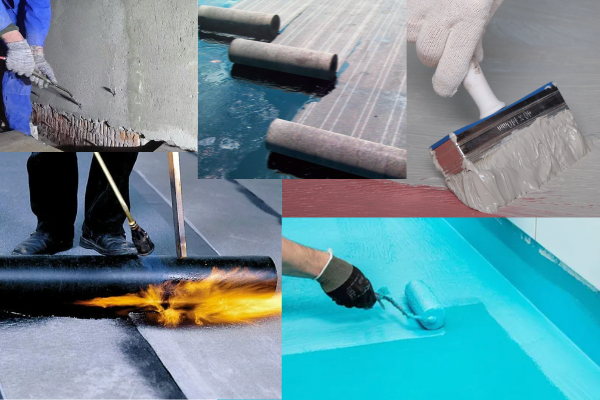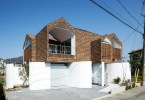Almost all modern structures, from residential buildings to artificial reservoirs, bridges, and pipelines, need high-quality protection from moisture. For this purpose, waterproofing materials of various types are used, which include various components.
The choice of a certain type of waterproofing is based on the operating conditions of the structure, the features of the terrain in which it is located, and many other factors. This article will focus on popular hydrophobic compounds and technologies for their use.
What is waterproofing and why it is necessary?
High-quality waterproofing – is a measure, necessary to protect structures for various purposes from the effects of moisture. Hydrophobic treatment of structures allows you to protect walls, roofs, foundations, balconies, basements, and other elements of residential buildings from dampness, as well as reliably protect walls, ceilings, and floors of rooms, especially those characterized by high humidity. Waterproofing is applied to all structures and premises that may be threatened by the impact of water, including washing, thawed, ground, condensate, and others.
Modern waterproofing materials allow you to create a strong and durable waterproof coating that is resistant not only to contact with water but also to the effects if temperatures, ultraviolet radiation, hazardous chemicals, and microorganisms.
In modern construction, there are many types of waterproofing, ranging from old materials like roofing material and ending to technological compositions, such as for example, mixtures based on acrylic, polyurethane, and other polymeric substances or liquid rubber. All types of materials differ from each other in their application features, operating conditions, and purpose. Later in the article, we will talk in detail about the most common types of waterproofing materials.
What can be the consequences in the absence of waterproofing?
Most of the materials used to build houses or other structures, such as concrete, bricks, or blocks, are porous structures that absorb water and moisture and are destroyed by prolonged exposure to them. This destruction can lead to the following consequences:
- Water leaks inside the operated spaces and residential premises;
- Increased humidity in residential or administrative premises, which is formed as a result of moisture accumulation in concrete materials, brick, or other compositions;
- The formation of mold, formed as a result of water entering the room or into the structure of concrete, bricks, and other materials;
- Formation of cracks and defects in the foundation, walls, floor slabs, and other structures. As a rule, cracks are formed as a result of prolonged exposure to water on the porous structures of concrete and brick products, and a constant temperature drop. In fact, water is absorbed into a porous structure, for example, concrete, freezes in winter, thaws in spring, and thereby leads to the gradual destruction of the structure, the formation of microcracks, and then more serious cracks and defects.


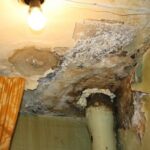
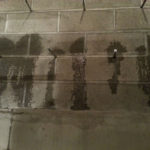
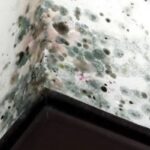

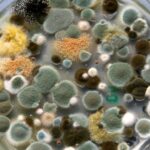

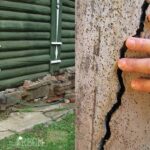
Learn more about problems in individual building structures:
The lack of waterproofing where it is necessary can lead to serious problems. For different designs, they can be as follows:
- For the foundation: subsidence of the foundation, the appearance of damp areas in the lower part of the house, including the floors of the first floor, corrosion destruction of fittings built into the foundation, the appearance of mold, fungus, the growth of mosses and lichens dangerous to human health;
- For roofing construction: wetting of insulation, the appearance of areas of dampness and mold, freezing of rooms in the upper part of the house in the cold season, coating of metal elements of the roofing structure with corrosion products;
- For bathrooms: the appearance of rusty stains on various surfaces, the destruction of the floor due to increased humidity, the formation of fungus and mold on the floor, ceiling, and walls of the bathroom, and the appearance of a musty smell in the room (not only unpleasant but also dangerous to health) the failure of plumbing, flooding of neighbors from below and increased costs for repair work;
- For basements: the destruction of the walls, floor, and ceiling of the basement under the influence of groundwater, the formation and active growth of areas of dampness, mold, and fungus, damage to structures located directly above the basement or being part of it (for example, the foundation, the lower floors of the house, and so on));
- For swimming pools and artificial reservoirs: ingress of dangerous substances contained in the soil into the water, “blooming” of water, poisoning of fish, plants, and other organisms, destruction of the base material of the pool or reservoir, the appearance of a threat to the health of those, who find themselves in the reservoir.
Only a few consequences of neglecting the installation of waterproofing were presented above.
Important: it is much more efficient to spend a little time and money on hydrophobic treatment of vulnerable structures at the construction stage than to deal with the consequences and spend much money on repairs.
In favor of which waterproofing materials can you make a choice?
Types of waterproofing materials, their characteristics, and application technology
The most popular types of waterproofing materials will be discussed in detail below.
Bitumen-based coating
Such waterproofing is made on the basis of widespread and not very expensive bitumen and therefore has an affordable price. As a result of processing the structure, it is possible to form a waterproofing coating that includes from one to 2-3 layers and has a thickness of several millimeters.
The optimal coating thickness recommended by manufacturers is considered to be a value of 3 mm. Bitumen — is a substance dangerous to human health, therefore, such waterproofing is used mainly for the external treatment of foundations, walls, artificial reservoirs, bridges, and in some cases for the protection of roofing structures.
Application technology:
There are several types of bitumen waterproofing that differ from each other in application technology:
- Cold application – More standard bitumen mastics are applied to the surface in a cold way, manually or with the help of special equipment. In most cases, builders make do with the usual spatula or rollers, however, special airless sprayers are often used to ensure uniform and economical distribution or material over the work surface.
- Hot application – it is best to work with hot application mastics only for professionals since this process involves the use of a flammable gas burner. This material is heated directly in the package until it reaches the required viscosity and consistency. Only after that, it is possible to process the hydrophobic treatment of the structure.
Specifications:
Below are the main characteristics of bitumen-based coating waterproofing:
| Material name | Strength | Conditional viscosity | Elongation at break | Price per 1 kg | Application Features |
| Bitumen-rubber mastic of hot application | 0,3 MPa | 15 | 100 % | 24,0 | It is used for sealing roofs, foundations, and pipelines |
| Bitumen-polymer mastic of hot application | 0,2 MPa | 14-28 | 100 % | 58,5 | It is used for processing foundations, roofs, and underground structures |
| Bitumen-roofing mastic of hot application | 0,3-0,5 MPa | 15 | 100-300% | 32,0 | It is used for sealing cracks and seams of various coatings, for waterproofing roads |
| Bitumen-rubber mastic of cold application | 0,3 MPa | 15 | 100 % | 69,0 | it is used for sealing roofs, pipelines, and highways; does not need heating |
| Bitumen-rubber mastic of cold application | 0,2 Mpa | 14-28 | 100 % | 70,0 | It is used for the treatment of roofs and underground structures; does not need heating |
Advantages:
Among the advantages of bitumen-based coating of hydrophobic materials, the following points can be distinguished:
- The high degree of adhesion to various surfaces;
- Uniform distribution on the base, filling of all micro-holes of the surface;
- Excellent elasticity, high strength, and water resistance;
- Reliable protection of the base from mold, mildew, dampness, rotting, and corrosion;
- Ease of application, long service life while maintaining the original characteristics of the coating;
- Economical material consumption even with the manual application is a reasonable cost.
Disadvantages:
About the disadvantages, we can say the following:
- It takes quite a long time for each layer to dry;
- Compositions of low quality eventually lose their performance properties, become cracked, and peel off.
Popular manufacturers:
If we talk about manufacturers of bitumen mastics, then we can distinguish both domestic and foreign companies that produce high-quality bitumen waterproofing. Among them, the following companies can be distinguished:
- Ikopal– high-quality bitumen mastics used almost everywhere, starting from the foundations of residential buildings and ending with bridges designed for the movement of trucks. Ikopal materials include in their composition a lot of elasticizers and other useful additives that provide excellent hydrophobic coating performance.
- Technonicol – waterproofing, perfectly suitable for processing concrete, wooden, metal, brick, and other structures. Such compositions are used in a wide temperature range and are considered as one of the most popular in the domestic construction market.
- Aquamast – cold-applied mastic, ready for use immediately after opening the package. Such waterproofing forms a strong waterproof coating on the surface and blocks the appearance of mold and dampness, as well as the reproduction of fungi and other dangerous microorganisms.
You can read more about bitumen waterproofing in the following article – «Bitumen waterproofing: types, characteristics, and technology of the arrangement».
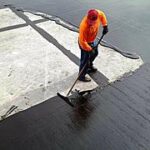

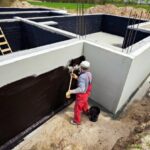
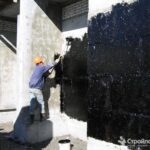
Polyurethane compounds
Polyurethane waterproofing is made on the basis of polyurethane resins and represents liquid compositions undergoing polymerization immediately after application to the treated surface. The polymerization process continues for quite a long time after the application of the material and increases as water enters the hydrophobic coating. To date, single-component, that is, ready-made and double-component polyurethane compositions are distinguished, which should be prepared before use.
Such compositions have the property of completely repeating the work surface, penetrating into all the cracks and micro-holes of the base. In addition, polyurethane waterproofing does not include toxic substances and therefore is suitable not only for external but also for internal processing of various structures.
Application technology:
At the initial stage of working with double-component compositions, it is necessary to combine and mix the liquid emulsion in the correct ratio, resulting in material of thick consistency.
The materials in question are applied to the base only after it has been thoroughly cleaned and degreased, and the necessary tools are a roller or a paintbrush with a fairly rigid brush. It is not always rational to use sprayers for polyurethane compositions, since the materials in question are characterized by a moderately thick consistency. However, the mechanical method also takes place.
A special sprayer is used for it, and after that, the hydrophobic composition is manually distributed. Upon completion of polymerization of the first layer of waterproofing, several more layers are applied to the surface, the number of which is determined by the manufacturer’s recommendations. The viscous consistency of waterproofing based on polyurethane resins makes it possible to process vertical surfaces with their help.
Specifications:
The main characteristics of polyurethane hydrophobic compositions (liquid membranes, mastics, etc.):
| The name of the indicator | Value |
| Dry residue | 95 % |
| Density, g/ cubic sm | 1,3-1,4 |
| Time interval between layers | 6-24 hours |
| Drying time (25 degrees Celsius, humidity of 55%) | 6 hours |
| Full polymerization time | 7 days |
| Temperature stability | from -40 to +80 degrees Celsius |
| Expiration date | 18 months |
| Packaging | 1, 3, 10, 20 kg |
Advantages:
Polyurethane waterproofing is popular for a reason. Among its advantages are:
- High strength, elasticity, and resistance to moisture, and all these properties are preserved throughout the entire period of operation;
- Compatibility with various climatic conditions, as well as resistance to temperature changes, ultraviolet radiation, and high humidity;
- The high degree of adhesion to any mineral bases having a porous structure;
- Long service life (several decades), determined by the high mechanical stability of hydrophobic compounds;
- Ease of application and a wide range of polyurethane waterproofing in construction stores.
Disadvantages:
There are not too many disadvantages of polyurethane waterproofing, and the main one – the high cost– is compensated by the payback of materials that over time improve operational properties, rarely need repair, and repair work itself is carried out very quickly and cheaply (by applying a new layer of waterproofing to the damaged area)
Popular manufacturers:
Popular manufacturers of polyurethane waterproofing include:
- Hyperdesmo – single-component liquid membranes used for waterproofing roofs, foundations, basements, walls, and other structures. They are characterized by a high degree of protection of the base from corrosion and from exposure to sunlight.
- Decoflex – liquid membranes ready for use immediately after opening the package. They form an elastic vapor-permeable coating that is resistant to any climatic conditions, as well as to mechanical and chemical influences.
- PolyFlex – is a German Hydro company that produces high-quality industrial waterproofing materials for the needs of specialized companies specializing in durable high-quality waterproofing.
You can read more about polyurethane compounds in the following article – “Polyurethane waterproofing”.






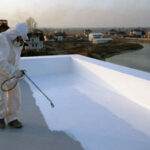
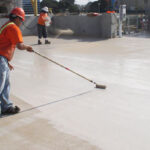
Cement waterproofing
Coating cement waterproofing is divided into two types: elastic and rigid. In modern construction, elastic materials are much more often used, capable of covering cracks up to 0.5 mm thick. In most cases, the cement mixture underlying such waterproofing is supplemented with polymeric substances that increase the strength and mechanical stability of the coating. Cement-polymer waterproofing is used for the treatment of any surfaces, including complex ones, such as the surfaces of swimming pools, reservoirs, sewage treatment plants, piers, elements of transport systems, mines, foundations, and other structures.
Application technology:
Work with cement-waterproofing necessarily begins with the preparation of the base: it should be cleaned, degreased, treated with a primer (using a roller), and get rid of cracks and seams using repair compounds or sealing tape. Also, before using cement-based materials, the working surface is moistened, since when waterproofing is applied to a dry base, the coating undergoes cracking and often peels off from the base. The dry cement mixture is prepared before use in accordance with the manufacturer’s instructions.
After that, cement waterproofing is applied to the work surface manually (spatula) or mechanically (shotcrete). In both cases, it is necessary to ensure an even distribution of the material on the base, bearing in mind that the waterproofing sets fast enough. After that, using “wet” technology, the second and third layers can be applied. This method involves wetting the first layer of waterproofing.
Specifications:
Below are the main characteristics of cement waterproofing:
| Name of the indicator | Value |
| The density of the finished mixture, g./cubic sm | 1,25-1 |
| Water-holding capacity | 95 % |
| Grip strength | 1,7 MPa |
| Overlapping cracks | 0,8 mm |
| Compressive strength | 46 MPa |
| Consumption, kg/sq.meter | 1,5-1,8 |
| Viability of the mixture | 45-60 minutes |
| Solidification time | 6-24 hours |
Advantages:
The advantages of cement waterproofing include the following points:
- The possibility of using cement waterproofing to work with both residential structures and industrial enterprises;
- High resistance to moisture and temperature changes;
- Compatibility with wet and even wet surfaces;
- The high degree of adhesion to various substrates, excellent compatibility with concrete;
- Ease of application, reasonable cost;
- Vapor permeability and environmental safety.
Disadvantages:
Among the disadvantages of the materials under consideration – are their tendency to crack with insufficient moistening of the working surface and low elasticity, which becomes noticeable with the slightest deformations of the structure. However, with the proper application of cement waterproofing and compliance with the requirements for its care, the manifestations of these shortcomings can be avoided.
Popular manufacturers:
Popular manufacturers of cement waterproofing are:
- Ceresit CR 65 – is a composition as a result of which a thin and transparent, but at the same time very strong film is formed, capable of repelling water. Ceresit is used for processing rooms with any humidity level, as well as for underground structures.
- Bergauf Hydrostop — is an example of standard cement waterproofing used in rooms with low and medium humidity. With the help of this composition, the walls, foundations, and floors of residential buildings are processed. The main disadvantage of the products of this manufacturer is the high probability of cracking of the hydrophobic coating.
- HydroPaz – is a super elastic waterproofing that is able to withstand not only the pressure of water on it (positive pressure) but also negative pressure from the outside to the inside.
You can read more about cement waterproofing in the following article – „Cement-based waterproofing: Features, types, and methods of its application”.
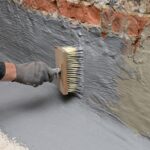
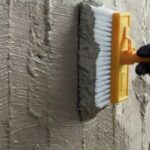
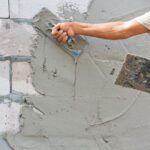

Bitumen-based roll materials
The traditional method of waterproofing is the use of roll-type materials, which can be pasted or surfaced. Roll waterproofing is used to protect foundations, floors, roofing structures, basements, socle floors, and cellars, as well as hydraulic structures, pipelines, artificial reservoirs, and fountains. Despite the fact that this type of material has its drawbacks, they are widespread in modern construction not only due to its low cost but also due to its useful characteristics.
Application technology:
The technology of laying roll waterproofing is determined by the type of materials. For example, the pasting compositions are laid on the work surface (after careful preparation) using adhesive compositions or using a mechanical method (the use of self-tapping screws). Adhesive compositions are used much more often, and their action is aimed at melting bitumen, which covers the inner surface of the rolled material, with the help of chemicals. In the case of surfaced waterproofing, gas burners are used to melt bitumen, the work with which is best entrusted to professionals. After heating up the material, it is laid on the work surface.
Specifications:
The main characteristics of bitumen-based roll materials are presented below:
| The name of the indicator | Value |
| Film thickness | 3-4 mm |
| Weight of 1 square meter of material | 3,9-5,2 kg |
| Thermal stability | from +85 to +130 degrees Celsius |
| Water absorption with 1 day | No more than 1% |
| The weight of the binder per 1 square meter | Not less than 2 kg |
| Flexibility | from -25 to +5 degrees Celsius |
| The strength of the connection with the concrete | No less than 0,2 MPа |
| The strength of the connection with metal | No less than 0,2 MPa |
| Service life | from 10 to 35 years |
Advantages:
Among the advantages of rolled materials, the following points can be distinguished:
- Formation of a comfortable humidity level in residential premises;
- Reducing the likelihood of mold, fungi, and dangerous microorganisms;
- Absolute safety for human health;
- Preservation of insulation properties throughout the entire service life;
- The high degree of resistance to stretching and other deformations.
Disadvantages:
The disadvantages include:
- The presence of seams in the waterproofing coating, which eventually diverge and begin to pass water;
- There is no full-fledged adhesion to the base and for this reason, if water gets through a weak spot under the material, it spreads over the surface, forming leaks in weak places;
- Rolled materials are prone to the formation of blisters, tears, and detachments if they are used incorrectly.
Despite some negative features of roll waterproofing, it is considered one of the most common types of waterproofing. However, the laying of such materials, especially those that belong to the surfaced type, would be best entrusted to professionals.
Popular manufacturers:
Among the popular manufacturers of roll waterproofing are:
- Technonicol. Rolled materials from this manufacturer are stored in the form of rolls at temperatures from -35 to +35 degrees Celsius. Such materials are characterized by a self-adhesive bottom layer, ease of installation, compatibility with combustible bases, as well as long service life, often exceeding 40 years.
- Stekloisol. Materials that can only be laid on flat bases (their angle of inclination should not exceed 10 degrees). They are used for processing both internal and external structures and can be mounted suing gas burners.
- Hydroisol. Hydrophobic roll-type compounds are excellent for waterproofing roofing structures, foundations, and other structures. Gas burners or bitumen mastics can be used for their installation. If an experienced builder takes up the task, then installation can be carried out very simply and quickly.
You can read more about roll materials in the following articles:
- The arrangement of the surfaced roof: Types of rolled surfaced materials and the technology of their assembly
- Roll waterproofing arrangement with detailed installation instructions



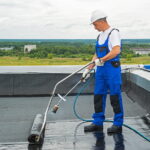
Membrane waterproofing
The use of membranes for waterproofing various structures is considered an innovative approach to this field of construction, designed to replace the use of roofing material, roofing, bitumen, and other traditional materials. Thin and high-strength waterproof membranes can be mounted on both horizontal and vertical surfaces, and the installation process itself is safe since it does not require the use of priming compounds and burners. The main “consumers” of membrane waterproofing include roofs, foundations, underground structures, reservoirs, and other structures.
Application technology:
Before laying the membrane on the base, it should be carefully prepared – cleaned, sanded, rid of cracks, and also equipped with geotextile, on top of which the hydrophobic membrane will be mounted. Before starting work, it is recommended to protect the geotextile with a plastic film. After that, the membrane itself is mounted by hot air treatment or using the adhesive method. The first involves the use of special driers or equipment, the second is carried out with the help of special adhesive compositions.
Specifications:
Below are the main characteristics of membrane waterproofing:
| The name of the indicator | Value |
| The permissible deviation in thickness | 10 % |
| Tensile strength | 11 MPa |
| Critical elongation | 465 % |
| Brittleness temperature | -45 degrees Celsius |
| Vapor permeability, g/sq. meter | 0,03 |
| UV resistance | Absence of both deep and surface cracks |
Advantages:
The advantages of membrane waterproofing include the following points:
- High water resistance, resistance to mechanical, chemical, and biological effects;
- Excellent crack resistance, low water absorption;
- High levels of flexibility and strength;
- Lightness (not more than 1 kg per 1 sq. meter);
- Resistance to sunlight and temperatures from -40 to +50 degrees Celsius.
Disadvantages:
- Among the disadvantages, the strength characteristics of the membrane can be distinguished;
- Also, membrane waterproofing is characterized by a rather high cost, which may be excessively large if it is a question of processing large areas;
- Presence of seams;
- Complete lack of adhesion to the base.
Popular manufacturers:
Popular manufacturers of membrane hydrophobic materials are:
- Technonicol — is a manufacturer that supplies the construction market with high-quality PVC membranes with high flexibility and is used for processing both aboveground and underground structures.
- Fatrafol — is a Czech company whose production is based on the manufacture of roofing membranes suitable for flat and pitched roofs and characterized by high strength, excellent resistance to moisture, and reasonable cost.
You can read more about membranes in the following article – “Membrane waterproofing: Types of materials and methods of their installation”.
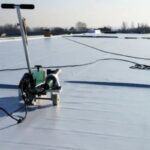
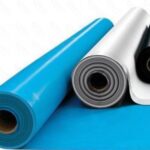



Liquid rubber
Liquid rubber is considered as one of the most high-quality and innovative hydrophobic materials. It has excellent adhesion to any surface, high strength, and elasticity, and also forms a seamless coating that is not prone to cracking over time. Liquid rubber belongs to the sprayed materials and is a bitumen-polymer emulsion that includes the main hydrophobic component and a hardener and does not need to be heated before use.
Application technology:
In most cases, it is sprayed liquid rubber that is used today, which is distributed over the work surface using special equipment. This type of application is carried out only by professionals and therefore is considered very expensive, but at the same time, it provides an economical consumption of material and its uniform application to the surface. Other types of liquid rubber – paint and bulk – are mounted without the use of special technologies. The paint waterproofing has a liquid consistency and is applied to the base using a paintbrush, roller, or spatula. The liquid is poured on the floor and is considered the cheapest option for liquid rubber.
Specifications:
Below are the main characteristics of liquid rubber:
| The name of the indicator | Value |
| Fire hazard | Not available |
| Release of toxic substances | Not available |
| Independent restoration of the coating | Available |
| Elasticity | Up to 1000% |
| Operating temperature range | from -50 to +85 degrees Celsius |
| Solidification time | Up to 1 minute |
| Elongation at break | 1000-1400% |
| Water absorption in 24 hours | Up to 1% |
| Expiration date | 18 months |
| Service life | 20-25 years |
Advantages:
The indisputable advantages of liquid rubber include the following points:
- Excellent adhesion to various substrates, the creation of a seamless monolithic coating;
- Seamless system;
- Full-fledged adhesion to almost any base;
- Simplicity and high speed of application, most often performed by professionals;
- High resistance to moisture, sunlight, and temperature changes;
- The possibility of self-healing of the coating in case of minor damage, as well as ease of repair work;
- Fire safety, absence of toxic substances in the composition, low requirements for the condition of the working surface;
- Almost absolute water resistance of the coating is based on liquid rubber.
Disadvantages:
Among the disadvantages, it should be highlighted:
- High cost of hydrophobic material;
- Difficulties arising during the dismantling of the coating;
- Vulnerability of liquid rubber to contact with solvents containing petroleum products;
- The need to use special equipment for the installation of waterproofing.
Important: In most cases, the disadvantages of liquid rubber turn out to be insignificant compared to its positive features, therefore, this material is very often chosen for hydrophobic treatment of various structures.
You can read more in the article – “Waterproofing with liquid rubber“.










Penetrating waterproofing
Penetrating waterproofing is intended primarily for those materials that have a porous structure and therefore need deep hydrophobic treatment. Compositions of the penetrating type, after applying them to the work surface, fall into all cracks, micro-holes, and pores of the base, thereby providing its reliable protection from moisture. The intensity of the waterproofing work and the depth of its penetration into the thickness of the material are affected by the degree of moistening of the base: the higher it is, the better the waterproofing will work.
Application technology:
Like other waterproofing materials of the coating type, penetrating compounds are applied only to thoroughly cleaned and prepared bases. They are distributed over the surface in several layers, and before starting work, it is necessary to thoroughly moisten the surface and dry it so that is not wet, but at the same time not dry. To work with penetrating waterproofing, it is best to use spatulas and rollers, which will help distribute the composition most evenly. The main method of working with the materials under consideration -is manual technology.
The scheme of the penetrating material:

Specifications:
Below are the main characteristics of penetrating waterproofing:
| The name of the indicator | Value |
| Humidity | Not more than 0,3% by weight |
| Solidification time | 40-160 minutes |
| The density of the finished mixture kg/cubic meter | 1650-1750 |
| UV resistance | Available |
| Application in drinking tanks | Available |
| Acidity of the application medium | pH from 3 to 11 |
| Operating temperature | from -60 to +400 degrees Celsius |
| Expiration date | 18 months |
Advantages:
Among the advantages of penetrating waterproofing:
- For applying materials, you can use the simplest tools (paint brush, roller);
- Improvement of the properties of bases having a porous structure;
- Preservation of the “breathing” properties of the base material;
- No need to dry the work surface before applying waterproofing;
- Environmental safety, allowing the use of such materials both outside and indoors.
Disadvantages:
The disadvantages include the following points:
- Before applying the composition, it is necessary to thoroughly moisten the surface;
- It will be quite difficult to remove the hydrophobic coating;
- Penetrating compounds do not work when applied to low-quality porous concrete or brick;
- Wide cracks should be repaired with repair solutions before hydrophobic surface treatment;
- It is forbidden to carry out work at negative air temperatures, and it takes quite a long time for the coating to dry;
- The activity time of penetrating waterproofing is limited, so it should be prepared in small quantities and used immediately after the preparation.
Popular manufacturers:
Popular manufacturers of this type of waterproofing are:
- Penetron — is a manufacturer of high-quality waterproofing for swimming pools, bathrooms, garages, and basements. Materials of this brand are characterized by economical consumption (up to 1 kg per 1 square meter) and an acceptable price (about 330 roubles per 1 kg).
- Lakhta — a domestic manufacturer that manufactures single-component compositions based on cement, which, after being applied to concrete, practically merge with the base into a single whole. With the help of the compositions of this company, artificial reservoirs, balconies, garages, basements, and reservoirs intended for the storage of drinking water are processed.
You can read more about penetrating compounds in the following article – “Penetrating waterproofing: A detailed description of its work on concrete, types of materials and application technologies“.
Injection waterproofing
Injection waterproofing helps residents of private and apartment buildings to fight dampness, mold, and fungi, as well as the effects of sedimentary, condensate, and groundwater when there is no access to the structure from the outside. During the construction of materials of this type, a strong waterproof barrier is formed between the structure and the aggressive environment with which it comes into contact. The main material is either introduced deep into the base or fills the space between the outer surface of the structure and the finishing coating. As a result, the hydrophobic composition penetrates into the smallest cracks, crevices, and capillaries of the bae, while creating an elastic hydrophobic barrier.
Application technology:
The use of injection waterproofing is possible in two ways: by feeding a hydrophobic composition without pressure at an angle of 40 degrees to the surface or by feeding the material under pressure. The second option is the most effective and often used, as it allows the material to penetrate deep into the structure, filling voids and microcracks.
Work with injection waterproofing begins with surface preparation, determining the injection area, and making the right number of small holes. Special nozzles are inserted into these holes, through which the waterproofing material is fed deep into the base using pumps or hoses.
Important: Only specialists can determine the complexity, duration, and scope of work, as well as the list of necessary equipment, after a thorough inspection of the structure with which they plan to work.
The scheme of the penetrating material:

Specifications:
The main characteristics of injection waterproofing are presented below:
| The name of the indicator | Value |
| Number of components | 1-3 |
| Elongation | 300-1000% |
| Feed pump | 1К-2К |
| Waterproofing of working seams | Available |
| Waterproofing of expansion joints | Available |
| Waterproofing of communication entry points | Available |
| Repair of membranes | Available |
| Soil stabilization | Available |
Advantages:
The advantages of injection waterproofing include:
- Very effective material for waterproofing protection, working on negative water pressure, when it is impossible to perform work from the outside;
- The opportunity to save time and finances on digging up the foundation or dismantling the roofing layers;
- Penetration even into the smallest holes of the base material;
- Formation of a high-strength waterproof coating;
- Environmental safety, including for drinking water;
- For some compositions, the solidification time is only a few seconds.
Disadvantages:
The disadvantages are considered to be the high cost of materials and equipment, as well as the need to contact specialists for the installation of waterproofing. However, these few disadvantages are successfully compensated by the positive properties of injectable compositions.
You can read more about the injection method of waterproofing in the following article – “Injection waterproofing“.










Comparative table of the main properties of waterproofing materials
To understand the main differences between the most famous waterproofing systems, as well as the examination of their advantages and disadvantages, you can study the following table:
| Liquid rubber and Polyurethane materials | Bitumen-based coating mastic | Surfaced bitumen-based materials | PVC membranes | Cement materials | |
| Mounting method | Non-firing By spraying Manually using a roller or brush | Non-firing Manually using a roller or brush | Firing With a special roller | Hot air Mechanical fixation with slats With a special roller | Non-firing Manually using a roller or brush |
| Work on negative water pressure | Not available | Not available | Not available | Not available | Available |
| Number of layers | 1-2 layers | 2-3 layers | 2-3 layers | 1 layer | 1-2 layers |
| The need for pre-priming | Available | Available | Available | Not available | Not available |
| Seams and joints in waterproofing coating | Not available | Not available | Available | Available | Not available |
| Adhesion to the base | 100 % | 100 % | 20 % | No adhesion | 100 % |
| Coefficient of elasticity | 600-800% | 50-200% | 10-20% | 10-20% | 50-80% |
| Installation speed m2/ per 1 day | 400-600 | 20-50 | 20-50 | 30-60 | 100-150 |
| The warranty period for works | 7 years | 1-2 years | 3-5 years | 1-2 years | 5 years |
Recommendations for the choice of waterproofing depending on the design
It is necessary to approach the choice of a particular type of waterproofing very carefully since different types of materials differ from each other not only in the nature of the application and technical characteristics but also in purpose and operating conditions. The best option would be a composition that is able to reliably and for a long time protect the selected structure from moisture.
For example, for external waterproofing, it is necessary to have excellent adhesion to the base, the absence of seams, high elasticity, compensation for shrinkage and other deformations, as well as resistance to aggressive chemicals contained in groundwater or soil. Based on the listed properties, it can be noted that polyurethane waterproofing, liquid rubber, polyurea, and cement-based compounds with the addition of polymeric substances are perfect for the external treatment of structures.
Also, when choosing the type of waterproofing, it is necessary to rely on such indicators as:
- The warranty period provided by the construction company that will be involved in the installation of waterproofing (it should not be less than 7-10 years);
- Payback of a particular type of waterproofing (high-quality compounds may cost more than competitors, but at the same time need much less significant repair costs);
- Methods of applying or laying waterproofing, possible costs for renting specialized equipment.
In order to make the right choice, it is important to study the technical characteristics of various types of waterproofing and the conditions in which they are planned to be used.
On which constructs should waterproofing be applied?
A lot of different types of structures need hydrophobic treatment today, and for many of them, it is necessary to install waterproofing from two sides at once — from the inside and from the outside. Let’s look at the structures that need to be waterproofing in a little more detail.
In private houses, apartment buildings, and administrative buildings, the following elements are traditionally subjected to hydrophobic treatment:
- Foundation;
- Walls;
- Roofs;
- Floor slabs;
- Floors.
Swimming pools, artificial reservoirs, as well as technological tanks, and reservoirs with drinking water are necessarily subjected to both internal and external hydrophobic treatment. From the outside, the base is, protected from the effects of groundwater and various microorganisms.
Materials that are in constant contact with liquid and therefore need increased protection from it are processed from the inside. For the structures listed above, it is important to use environmentally friendly materials that do not have a negative impact on the water stored inside the structure. In addition, the best option would be the use of those compounds that form a seamless coating on the working surface, since the seams only become an additional weak point of the structures under consideration.
Recommendations for external waterproofing of underground parts of buildings and structures, such as foundations and walls of basements, tunnels, socle floors
All underground parts of buildings need high-quality protection from water, especially if there is an operating structure underground, for example, a basement, but even if there is not, the underground parts of the structure should be protected from the effects of water.
Underground waterproofing has its own characteristics and as a reliable and durable waterproofing, we recommend using waterproofing systems with the following characteristics:
- Absence of seams (so-called seamless systems);
- Having 100% adhesion to the base of concrete, blocks, or bricks;
- Having a high coefficient of elasticity, to prevent the formation of cracks and ruptures during the shrinkage of the foundation or its dynamic movement;
- Resistant to aggressive environments, for example, salts and minerals, located in the ground or groundwater.
One of these types of materials is the so-called liquid rubber. If we talk about the most durable protection from water, then in addition to high-quality waterproofing around the perimeter of the building, at a level below the occurrence of the foundation slab, it is recommended to install a drainage system that will help divert water from the foundation and walls and thereby weaken the pressure on the performed waterproofing, which will lead to the fact that this waterproofing will last 3 times longer. You can read more about drainage installation in the article – “Turnkey drainage installation around the house: Proper drainage, its types, installation technologies, materials, schemes, and prices”.
You can read more about the methods and materials for the installation, and high-quality waterproofing of underground parts of buildings in the following articles:
- Waterproofing of underground structures and parts of buildings
- Foundation waterproofing arrangement: Methods, materials, prices, and recommendations of specialists
- Waterproofing of basement and house walls from outside and inside – Methods, materials, prices, and technology
- How to make waterproofing of the basement from the outside properly
- Waterproofing of the basement from the inside: Methods, materials, and stages of work
- Elimination of basement leaks once and forever
- Waterproofing of the socle: Recommended materials and technologies
Scheme of external waterproofing installation:

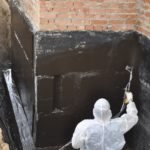
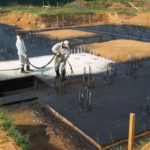
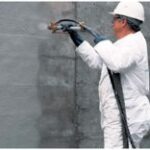
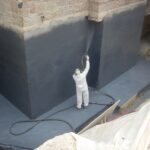

Recommendations for the installation of internal waterproofing of the foundation and walls of the basement or other underground structures.
If it is impossible to perform external waterproofing, the most effective way to protect the basement or socle from the inside is to use an injection method of waterproofing in combination with special types of mineral acrylic compounds that can withstand negative water pressure from the outside to the inside.
As a rule, injection — is an expensive technology, respectively, it should be performed in the weakest areas of the structure, namely cold seams, interlocking seams, and destroyed sections of concrete. The remaining surfaces can be covered with a special waterproofing compound that can withstand negative water pressure.
You can read more about the methods and types of materials for the installation, and high-quality waterproofing from the inside in the following articles:
- Waterproofing of basement and house walls from the outside and inside – Methods, materials, prices, and technology
- Waterproofing of the basement from the inside: Methods, materials, and stages of work
- Injection waterproofing
- Veil waterproofing
Diagram of the internal waterproofing arrangement by injection:



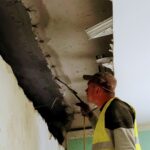
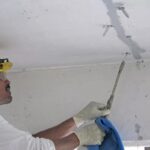
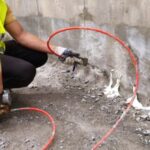
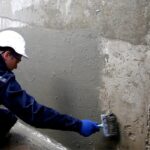

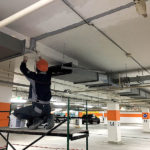
Recommendations for waterproofing roofs, balconies, and terraces
A roof, an open balcony, or a terrace are vulnerable areas of a house or building that are exposed to a large amount of precipitation, in the form of rain or snow. Waterproofing of such structures should be approached comprehensively, taking into account the following aspects:
- Additional protection of all cold seams, joints, and places of entry of communications;
- Arrangement of the desired slope, so that water does not stagnate on the surface and does not exert constant pressure on the performed waterproofing (when water stagnates, the waterproofing coating serves 2-3 times less than without pressure);
- Organization of high-quality drainage;
- Selection of high-quality materials, preferably from among seamless systems, such as polyurethane waterproofing or liquid rubber.
You can read more about the methods and different types of materials for the installation, and high-quality waterproofing of the roof or terrace in the following articles:
- Waterproofing of the roof: methods of its arrangement and types of materials for performing high-quality work
- Waterproofing of a flat roof. Recommended materials, methods of installation, and prices for work
- Waterproofing and repair of pitched roofs
- Roof waterproofing repair: Methods, materials, and prices
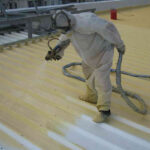

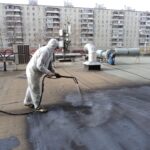

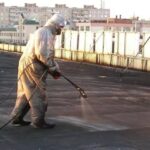
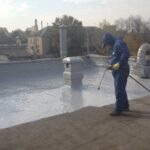
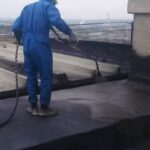
Comparison of prices for works on the installation of different types of waterproofing
| The name of the waterproofing method | The price of work per 1m2 in $. |
| Surfaced roll materials | 48 |
| Mounted PVC and TPO (Thermoplastic Polyoleofin) membranes | 60 |
| Bitumen coating mastics | 25 |
| Liquid rubber | 40 |
| Polyurethane mastics | 40 |
| Cement waterproofing | 50 |
| Penetrating waterproofing | 45 |
| Injection | 120 |
| Pasting materials | 40 |



